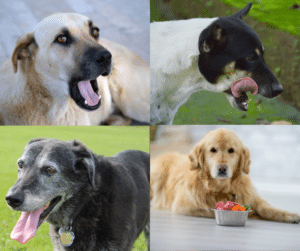Identifying stress in your pet is crucial for dog owners everywhere, including in Hamilton, where pet wellness is taken seriously. This guide will help you understand stress in dogs, recognise the signs, and provide practical advice to help them cope.
Common Signs of Stress in Dogs
Dogs can’t speak, but they have their own ways of communicating. Understanding these signs is vital, whether you’re at a dog park in Hamilton or relaxing at home. 
1. Excessive Panting
Panting is a dog’s way of cooling down, but when it happens without heat or exercise, it might indicate stress. Dogs can pant because they’re anxious or overwhelmed. If your dog is panting heavily while indoors or at rest, it could be their response to stress. This is a common issue addressed in dog training sessions in Hamilton, where trainers help owners identify stress triggers. Consider what might be causing their anxiety—loud noises, new people, or unfamiliar environments.
2. Licking Lips
Licking lips is another way dogs cope with stress. When they lick their lips excessively, they’re likely trying to calm themselves. This could happen in situations where they feel uncomfortable or threatened. If you see this sign, check what’s going on around them. Are there new people or pets? Is the environment chaotic or noisy? By identifying the source of stress, you can help your dog feel more at ease.
3. Yawning
Yawning isn’t just about being tired. Dogs use yawning to reduce their stress levels. It’s their body’s way of telling you they’re uneasy or bored. If you notice your dog yawning frequently in potentially stressful situations, it might be time to consider a calming routine, possibly involving some dog training techniques. Try taking them for a walk or playing with them to help them relax.
4. Pacing and Restlessness
Noticing this behaviour is common among dog owners in Hamilton, especially after moving to a new environment. When dogs pace or seem restless, they’re usually trying to work off nervous energy. It’s like when you’re anxious and can’t sit still—dogs feel the same way. If your dog is pacing a lot, think about what might be causing their unease. It could be a change in routine, a new environment, or something as simple as a loud noise outside. Find ways to help them settle down, like providing a cozy spot or playing some calming music.
5. Whining or Barking
Dogs express stress through their voices. Excessive whining, barking, or howling could mean they’re feeling stressed. If your dog usually keeps quiet but suddenly becomes vocal, they’re trying to communicate something. Look around for triggers—are there unfamiliar people or loud noises? If you’re not sure, try to comfort them and offer reassurance.
6. Changes in Appetite
Stress can affect a dog’s appetite. If your dog starts eating less or more than usual, it might be a stress response. They might lose interest in food because they’re anxious, or they might overeat to cope with stress. Keep track of their eating habits, and if you notice any drastic changes, consult with your vet to rule out any underlying health issues.
7. Trembling
Trembling or shaking in dogs can be a sign of stress. If it happens when there’s no cold weather or excitement involved, it’s likely due to anxiety. Trembling could also be a sign of fear. If your dog shakes frequently, try to identify what’s causing it and remove or minimise the trigger. This sign of stress is particularly important to address with professional help, possibly requiring the assistance of a dog training expert.
8. Avoidance Behaviour
Avoidance is a common stress response in dogs. They might avoid people, other dogs, or situations that make them uncomfortable. If your dog is hiding or running away from things, they’re probably stressed. Try to give them space and create a safe environment where they can retreat and feel secure. If your dog starts showing avoidance behaviour, it could be beneficial to consult with a dog training professional in Hamilton to better understand and address this stress response.
9. Aggression
Stress can lead to aggressive behaviour in dogs. If your usually friendly dog starts growling, snapping, or showing other aggressive tendencies, stress could be the cause. Aggression is a serious sign, and it’s important to address it quickly. Aggressive behaviours can be significant stress indicators that are often addressed through the help of a professional dog trainer in Hamilton.
10. Loss of Interest in Play
Dogs usually love to play, but stress can dampen their enthusiasm. If your dog starts ignoring their favourite toys or doesn’t seem interested in playing, they might be stressed. This loss of interest can indicate a deeper problem. Try to engage them with new activities and give them plenty of attention to help them feel better.
Why Dogs Experience Stress
 Dogs experience stress for a variety of reasons. Understanding these triggers can help you manage stress and keep your dog happy. Whether in Hamilton or elsewhere, dogs experience stress for various reasons. Understanding these can help you manage their stress better.
Dogs experience stress for a variety of reasons. Understanding these triggers can help you manage stress and keep your dog happy. Whether in Hamilton or elsewhere, dogs experience stress for various reasons. Understanding these can help you manage their stress better.
Environmental Changes
Dogs are creatures of habit. Sudden changes in their environment can be stressful. Moving to a new home, introducing new pets, or even rearranging furniture can unsettle them. Hamilton’s dynamic environment might stress dogs who thrive on routine. Try to keep their environment stable and introduce changes gradually to avoid stress.
Loud Noises
Dogs have sensitive hearing, so loud noises can be stressful. In Hamilton, fireworks, thunderstorms, or construction noises might scare them. If loud noises are causing stress, create a safe space where they can retreat, and consider using calming music or white noise to drown out the sounds.
Separation from Owners
Dogs are social animals and rely on their owners for comfort. Separation anxiety is a common cause of stress, especially if you leave them alone for long periods. To reduce stress from separation, gradually increase the time you’re away, and provide toys or puzzles to keep them occupied.
Health Issues
Sometimes, stress is related to health problems. If your dog is in pain or discomfort, they might exhibit stress-related behaviours. Regular check-ups with your vet can help catch health issues early and prevent stress from escalating.
Managing and Reducing Stress in Dogs
 If you’re in Hamilton, there are specific dog training techniques and local resources that can help manage your dog’s stress. If you’ve identified stress in your dog, there are steps you can take to manage and reduce it. These tips will help your dog feel more relaxed and comfortable.
If you’re in Hamilton, there are specific dog training techniques and local resources that can help manage your dog’s stress. If you’ve identified stress in your dog, there are steps you can take to manage and reduce it. These tips will help your dog feel more relaxed and comfortable.
Create a Safe Space
Give your dog a designated area where they feel secure. This could be a crate, a cosy bed, or a quiet room. Make sure it’s a space they can access whenever they need a break.
Maintain a Routine
Dogs thrive on routine. Keeping a consistent schedule for feeding, exercise, and playtime can reduce stress. Avoid sudden changes in routine, as they can trigger anxiety.
Provide Plenty of Exercise
Exercise is a great stress reliever for dogs. Regular walks, playtime, and trips to the park can help them burn off energy and reduce stress. A tired dog is more likely to be a relaxed dog.
Use Calming Products
There are products designed to help reduce stress in dogs, like pheromone diffusers, calming collars, and anti-anxiety wraps. Consult your vet before using these products to ensure they’re suitable for your dog.
Consider Professional Help
If your dog’s stress doesn’t improve with basic changes, consider consulting a professional dog trainer such as K9 Principles can help diagnose the cause of stress and suggest specialised treatments.
In Conclusion
 Whether you live in Hamilton or elsewhere, taking proactive steps to manage your dog’s stress is key to ensuring their happiness and well-being. Engaging in dog training can equip you with the tools needed to help your dog lead a stress-free life. Understanding and addressing stress in dogs is crucial for their well-being. By recognising the signs of stress and knowing the common triggers, you can take steps to keep your dog relaxed and happy. Whether it’s creating a safe space, maintaining a routine, or providing professional help, your efforts will make a difference in your dog’s life.
Whether you live in Hamilton or elsewhere, taking proactive steps to manage your dog’s stress is key to ensuring their happiness and well-being. Engaging in dog training can equip you with the tools needed to help your dog lead a stress-free life. Understanding and addressing stress in dogs is crucial for their well-being. By recognising the signs of stress and knowing the common triggers, you can take steps to keep your dog relaxed and happy. Whether it’s creating a safe space, maintaining a routine, or providing professional help, your efforts will make a difference in your dog’s life.
- Name: K9 Principles
- Address: Haldimand County, Greater Hamilton Area, Burlington and Most of Norfolk County
- Phone: 289 880-3382
- Email: k9principlesinc@gmail.com
- Website: www.k9principles.ca
FAQs
-
Yes, stress can lead to health issues in dogs. It can weaken their immune system, cause digestive problems, and lead to skin conditions. Reducing stress is important for their overall health.



